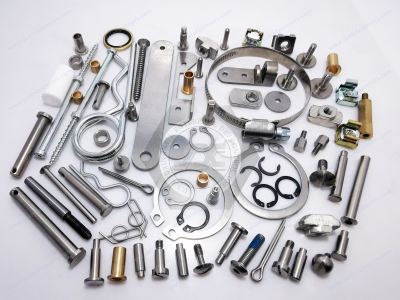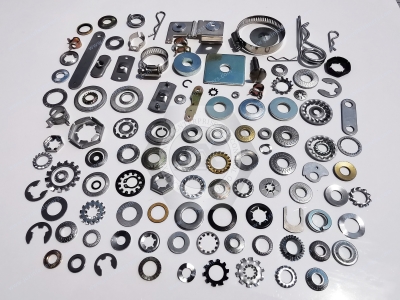Call Us
+86 136 6007 9809
Call Us
+86 136 6007 9809
Nov. 04, 2023
Stamping processing is a standard metal processing method widely used in the automotive, electronics, and home appliance industries. Through the pressure and shape of the mold, stamped parts can achieve a variety of complex geometries, including curves, holes, concave, and convex. This gives stamped parts greater design freedom in meeting different engineering requirements.
Metric General Purpose Washers: Steel washers are stronger and more wear-resistant than stainless steel. Steel washers without plating or coating are best for dry environments since moisture will cause them to rust. Blue-dyed steel washers have a unique color, so you can tell they're metric at a glance. Zinc- and zinc-yellow-chromate-plated steel washers have an outer layer of zinc that protects the inner steel from rust and extends the washer's life. Although more robust and wear-resistant than stainless steel, they are not as corrosion-resistant. Use them in wet environments, but avoid contact with salt water and chemicals. Zinc-flake-coated and black corrosion-resistant-coated steel washers have the same level of corrosion resistance—both resist corrosion from chemicals and withstand 1,000 hours of salt spray. The black corrosion-resistant-coated steel washers have a black semi-gloss finish. Galvanized steel washers are ten times as corrosion resistant as zinc- and zinc-yellow-chromate-plated steel washers.
At one-third the weight of steel, aluminum washers are the lightest option. They will not rust in wet environments.
Copper and brass washers are electrically conductive and resist rust in wet environments. Nickel-plated brass washers have a decorative finish.
Washers that meet ISO 7089, 7090, 7091, and 7092 (formerly DIN 125, 126, and 433) meet international standards for fastener dimensions. The ISO 7091 washers have a slightly rougher surface than a flat washer.
The characteristics of stamping processing are mainly reflected in the following aspects:
1. High efficiency: stamping processing adopts molds for mass production, which can complete the production of many products quickly and is characterized by high efficiency. Compared with other processing methods, stamping processing can realize multiple processes simultaneously, significantly improving production efficiency. The manufacturing speed of stamping parts is fast, and the production efficiency is high. The stamping press can continuously process large quantities of parts in a short period, which significantly improves production efficiency. At the same time, the manufacturing process of stamping parts is simple and does not require multiple processes, reducing processing time and cost. Washers with Material Certification: come with a traceable lot number and a physical and chemical test report. They're zinc yellow-chromate plated for corrosion resistance in wet environments.
2. High precision: Stamping processing uses molds, and the molds are characterized by high precision, which can ensure the consistency of the size and shape of the products. Stamping processing can realize the processing of complex parts, and the dimensional accuracy can reach a millimeter or even sub-millimeter level. Stamped parts are processed with high precision and can get millimeter-level accuracy requirements. Through the precise design of molds and mechanical operation, stamped parts can ensure the consistency of size and shape, making them more stable and reliable in assembly and use.
3. Strong adaptability: stamping processing can process parts made of different materials, including steel, aluminum, copper, etc. At the same time, stamping processing can process parts of various shapes, whether flat, curved, or complex parts. Stamped parts are usually made of metal materials with high strength and stiffness. Through stamping, the metal material can be deformed and hardened to a high degree, increasing the strength and durability of the stamped part. This gives stamped parts good mechanical properties and service life in various engineering applications.
4. High reliability: Stamping processing uses molds for processing, and the molds have the characteristics of high strength and high hardness and can withstand more significant impact and pressure. Therefore, the products of stamping processing have high strength and rigidity and can meet the requirements of use under various working conditions.
5. Material saving: Stamping processing processes parts by cutting, stamping, and forming metal sheets. Compared with other processing methods, stamping processing can maximize the use of metal materials and reduce the waste of materials. The manufacturing process of stamped parts allows maximum material utilization and reduced material waste through the tooling design and optimal use of materials. This gives stamped parts more significant advantages in resource utilization and environmental protection.
6. Stable process: Stamping processing adopts molds for processing, and the molds have fixed shapes and sizes, which can maintain stable process conditions during processing. Therefore, the products processed by stamping have high consistency and stability and can meet the quality requirements of the products. The manufacturing process of stamped parts can be realized through the duplication of molds, which ensures the repeatability and consistency of the parts. Regardless of the production batch size, the size and shape of the stamped parts can be effectively controlled, ensuring the stability of product quality.
7. Widely used: Stamped parts are widely used in various industrial fields, including automobiles, electronics, home appliances, construction, etc. Whether it is a sizeable structure or a tiny part, stamped parts can meet the needs of different applications. They can be adapted to various design requirements by adjusting and modifying molds.
Stamping parts have the above characteristics and significant application value in various fields as common metal processing parts. With the progress of science and technology and the improvement of processes, the manufacturing process and quality control of stamped parts are also improving, providing better solutions for various industries. At the same time, the development of stamped parts also drives the progress of mold manufacturing technology, becoming a significant force in promoting the development of the entire metal processing industry.
General Purpose Washers, Use these washers to evenly distribute the load under bolt or screw heads and nuts when fastening. They can also act as spacers.
Three hundred sixteen stainless steel washers resist chemicals and salt water. They may be mildly magnetic.
18-8 stainless steel and 17-7 PH stainless steel washers have good chemical resistance and may be mildly magnetic. 17-7 PH stainless steel washers are more robust than 18-8 stainless steel washers. Black-oxide 18-8 stainless steel washers have a matte-black finish.
Alloy 20 stainless steel washers have extreme corrosion resistance in marine environments and chemical-processing plants. They may be mildly magnetic.
A286 stainless steel washers withstand high temperatures. They have good chemical resistance and may be mildly magnetic.
Zinc yellow-chromate and chrome-plated steel washers are corrosion-resistant in wet environments.
Black corrosion-resistant-coated steel washers resist chemicals and withstand 1,000 hours of salt spray.
Aluminum washers are lightweight and corrosion-resistant in wet environments.
Copper, brass, and silicon bronze washers are corrosion resistant in wet environments, nonmagnetic, and electrically conductive. Silicon bronze washers are more robust than copper and brass.
Titanium washers are highly corrosion-resistant and suitable for marine environments and chemical processing plants. They may be mildly magnetic.
Four hundred nickel washers have excellent resistance to salt water and some acids. They may be mildly magnetic.
SAE washers generally have a smaller ID and OD than USS washers.
USS washers generally have a larger ID and OD than SAE washers.


The following features mainly characterize stamped parts.
1. Stamped parts are mainly made of metal or non-metallic plates under the pressure of the press through the stamping die, and the stamped parts are stamped under the premise of little material consumption. Its parts are light in weight and good in stiffness. The plastic deformation of the plate improves the metal's internal organization and increases the stamped part's strength.
2. Stamped parts have high dimensional accuracy, uniform size with the mold, and good interchangeability. No further processing is required to meet the general assembly and use requirements.
3. In stamping, since the surface of the material is not damaged, the surface quality is good, and the appearance is smooth and beautiful, which provides convenient conditions for surface treatment, such as surface coating, electroplating, and phosphating.
三、Stamping process also needs to consider the following aspects of factors:
1. Material selection: different materials have different processing properties and characteristics, and it is necessary to select the appropriate material according to the requirements of the product. The hardness, plasticity, and toughness of the material and other properties of the stamping process for the molding effect and product quality have a significant impact.
2. Mold design: The mold is the core tool of stamping processing, and its design directly affects the product's dimensional accuracy and shape complexity. Reasonable mold design can improve the efficiency and quality of stamping processing.
3. Process parameters: The process parameters of stamping include the impact force of the punch, the stamping speed, the cooling method of the punch, etc. Reasonable process parameters can ensure the efficiency and quality of the products. Appropriate process parameters can confirm the product's dimensional accuracy and shape consistency.
4. Surface treatment: The surface of stamping products usually needs to be treated, such as deburring, polishing, spraying, etc. Surface treatment can improve the appearance and quality of the products and their corrosion resistance.
Stamping is a metal processing method with high efficiency, precision, and adaptability. It is characterized by stable process, high reliability, and material saving and is widely used in various industries. The stamping process must consider material selection, mold design, process parameters, and surface treatment to ensure product quality and efficiency. With the development of science and technology, stamping processing technology is also constantly innovating and improving, providing strong support for the development of various industries.
If you are looking for high-quality automotive fastener screws & all kinds of plastic fasteners or technical support for structural design, please get in touch with me. Use our new Product Finder tool, download our Product Catalog, and let us help you get custom parts.adelajonly@gmail.com. Thanks. Website: www.juxinfasteners.com
Contact Us
Tel.:
+86 020 8621 0320
+86 020 3121 6067
Technical Support:
Navigation
SEND INQUIREY